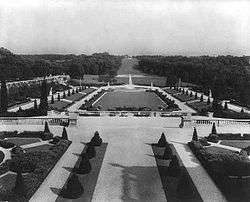Jacques Gréber
| Jacques Gréber | |
|---|---|
| Born |
10 September 1882 Paris, France |
| Died |
5 June 1962 (aged 79) Paris, France |
| Nationality | French |
| Occupation | Architect |
| Buildings |
Rodin Museum, Philadelphia |
| Projects | Greber Plan (Ottawa) |
Jacques-Henri-Auguste Gréber (10 September 1882 – 5 June 1962) was a French architect specializing in landscape architecture and urban design. He was a strong proponent of the Beaux-Arts style and a contributor to the City Beautiful movement, particularly in Philadelphia and Ottawa.
Early life and education
Gréber was born in Paris, the son of sculptor Henri-Léon Gréber, and attended the École des Beaux-Arts in that city. Following graduation in 1908,[1] he designed many private gardens in the United States. These include Harbor Hill (1910) in Roslyn, Long Island, New York for Clarence Mackay (with architects McKim, Mead & White); and at Lynnewood Hall (1913) in Elkins Park, Pennsylvania for Peter A. B. Widener (with architect Horace Trumbauer).
His greatest private commission was for investment banker Edward T. Stotesbury at Whitemarsh Hall (1916–1921) in Wyndmoor, Pennsylvania (also with Trumbauer). There he created the unsurpassed American example of a French classical garden in the grand manner of André Le Nôtre.[2]
Major works


Gréber is best known for the 1917 master plan for the Benjamin Franklin Parkway in Philadelphia;[3] for his work as master architect for the 1937 Paris International Exposition; and for the Greber Plan for Ottawa and the Canadian National Capital Region.[4] The latter, produced between 1937 and 1950 (with an interruption during World War II), included expansion of urban parks, a series of parkways, and a greenbelt surrounding the city. A metal plaque indicates that dedicated to the war dead of the Second World War, "This corredor forms part of the living memorial as envisaged by Jacques Gréber in his plan for a National Capital" [5]
In anticipation of the 1926 sesquicentennial of the Declaration of Independence, Gréber created a plan for a mall north of Independence Hall in Philadelphia. This included a "Great Marble Court" surrounded on 3 sides by arcades (with each arch representing a U. S. state) and a pavilion at its center to house the Liberty Bell. It was not carried out; Independence Mall was created in the 1950s under a different plan.[6] He also collaborated with fellow French-American architect Paul Cret on Philadelphia's Rodin Museum in 1926. He was not always popular with the press: a Philadelphia newspaper dubbed him "Jack Grabber".
In France, between the world wars, Gréber worked on urban plans in Lille, Belfort, Marseille (1930), Abbeville, and Rouen, Neuilly, Montrouge,[7] among others. But he is not as well-known today in France as he is in North America.

 "View to the Museum" (1918). Benjamin Franklin Parkway, looking northwest from 20th Street.
"View to the Museum" (1918). Benjamin Franklin Parkway, looking northwest from 20th Street.- Greenbelt surrounding Ottawa, Ontario (1950).
See also
![]() Media related to Category:Jacques Gréber at Wikimedia Commons
Media related to Category:Jacques Gréber at Wikimedia Commons
- Greber Plan (Ottawa)
- Gatineau Park
- Greenbelt (Ottawa)
Notes
- ↑ E. Delaire et al. Les architectes élèves de l'école des Beaux-Arts, 1793–1907 noted in James T. Maher, The Twilight of Splendor: Chronicles of the Age of American Palaces 1975:65 note 78.
- ↑ "Its unsurpassed French classical gardens" (Maher 1975:65).
- ↑ History of Benjamin Franklin Parkway
- ↑ 1950 Plan for the National Capital, Ottawa
- ↑ Jacques Gréber Ottawa
- ↑ Constance M. Greiff, Independence: The Creation of a National Park (Philadelphia: University of Pennsylvania Press, 1987), pp. 228, 258.
- ↑ Maher 1975:65 mentions Paris, Neuilly, Montrouge, Marseille, Ottawa and Philadelphia.
External links
- Web site about Clarence H. Mackay and Harbor Hill
- Gréber's plans for Whitemarsh Hall
- Gréber's bronze fountain from Lynnewood Hall